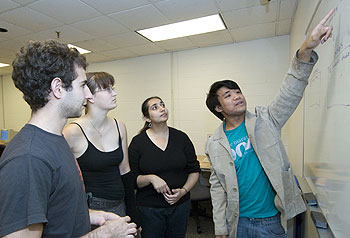Kenneth J. Goldman, Ph.D., associate professor of computer science and engineering in the School of Engineering, is taking a grant from the National Science Foundation (NSF) and helping his department transform the way undergraduates are taught.
Goldman, recipient of a $562,000 NSF grant, is working with his fellow investigators to cultivate “active learning” in the classroom with a significant increase in studio courses that involve team projects and interdisciplinary collaboration.

In a culture marked by frequent critique, students will refine their design skills as well as improve their ability to present and justify their designs and work in groups. Passive learning, typified by the traditional lecture, will be put on the backburner — though the flame still will burn low.
“At most universities, students spend the bulk of their in-class time passively listening to a lecture,” Goldman said. “They may ask a few questions, but nearly all of their active learning on problems and projects is done outside of class. We want to change that.
“Passive learning can be done effectively out of class. We want students to interact in the classroom more instead of hearing a lecture. As we phase in courses during this transformation, we will be making video and audio from lectures available on the Web. We can then assign these, much like reading assignments, so that students can arrive in class ready to do something with that knowledge.”
The planning for this transformation has been ongoing, involving many faculty and students. NSF support for this transformation was formally announced and discussed with computer science and engineering students on Oct. 10 at a meeting of the student chapter of the Association for Computer Machinery.
“Students seemed very enthusiastic,” Goldman said. “One student commented that more hands-on time will be better, and that of what he learns in computer science, only 10 percent is from lecture anyway.”
At the meeting, Goldman explained that undergraduate courses affected by this transformation will be divided into two groups: Foundations courses will concentrate on fundamental problem-solving skills; studio courses will be marked by application of foundational knowledge to design and to implement in teams. In both types of courses, students will experience active learning in the classroom and frequent critique from the faculty and other students.
“We want to raise the interaction level to a significant degree,” Goldman said. “I think this approach appeals to the engineering mentality. People are attracted to computer science and engineering because it is a creative discipline. Educational research shows that if students are creating during class, rather than sitting there listening, motivation will be higher and the students will learn more.”
Goldman noted that computer science and engineering never have been entirely passive, and that many design and capstone courses are hands-on where students have opportunities to develop presentation skills.
“But, we’re taking that up several notches,” he said. “We expect our students to become leaders in computer science and engineering, so they need to develop a strong technical foundation, strong communication and collaboration skills, the ability to carry out innovative designs and an understanding and appreciation of other disciplines and cultures. The goal of this transformation is to help students accomplish this more efficiently by integrating a lot more design activities and collaboration into class time.”
This fall, lectures from a number of courses, including “Computer Science I,” “Algorithms and Data Structures” and “Introduction to Systems Software,” will be broken up into smaller chunks.
As the active learning transformation is phased in over several years, passive content will be delivered through an online course management system (CMS). Students will be able to use some of that material to prepare for in-class learning activities that otherwise would have been done at home. The CMS also will help students track where they are in the curriculum and enable them to keep portfolios of their project work — useful in job searches and graduate-school applications.
The CMS also will support planning by providing information on prerequisites for each module in the curriculum and allow students from other areas who might want to participate in an interdisciplinary studio to find an efficient pathway through the curriculum to take such courses.
“Because course content will be separated into smaller modules, a student outside of computer science could work with a computer science and engineering (CSE) department faculty member to fashion an independent study that would get them up to speed in order for them to participate in an interdisciplinary studio in a meaningful way,” Goldman said.
In the spirit of being interdisciplinary, Goldman and the CSE department are collaborating with Peter MacKeith, associate professor of architecture, in studio-based instruction.
“Architecture has a long history of studio-based instruction,” Goldman said. “Peter will help faculty learn techniques for interacting with students more effectively in studio courses, and he will critique us along the way. It’s striking how similar the design processes are in computer science and architecture. We expect that much of the teaching technique will transfer well.”
R. Keith Sawyer, Ph.D., associate professor of education in Arts & Sciences and an investigator on the grant, will provide professional development for faculty in the area of active learning. As courses are phased in, Sawyer will help faculty plan active learning sessions that make the most of class time. Lynn Stein, Ph.D., of Olin College of Engineering in Boston, will provide curriculum support based on her multidisciplinary teaching experience at her school.
Other investigators from the CSE department are Ron K. Cytron, Ph.D., professor; Roger D. Chamberlain, Ph.D., associate professor; Christopher D. Gill, Ph.D., associate professor; and Cindy M. Grimm, Ph.D., associate professor.